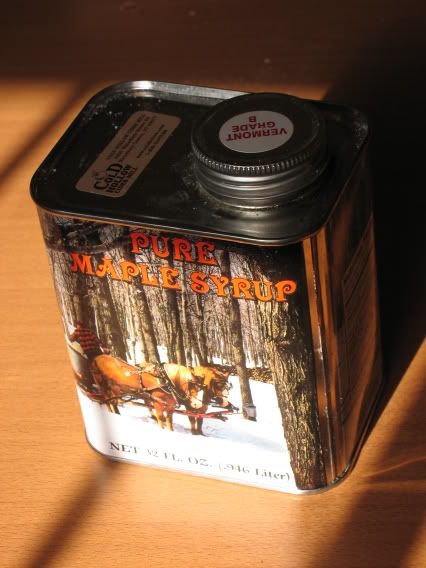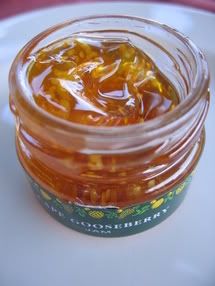Maple Syrup and Baked Beans
 While I was eating myself silly in Philadelphia, my dear friend Wendy-Bird was driving through Vermont with her boyfriend. Deeply familiar with my food obsessions (thanks to her years as a guineapig to some of my stranger culinary experiments) she thoughtfully brought me back a pint of Grade B Vermont Maple Syrup.
While I was eating myself silly in Philadelphia, my dear friend Wendy-Bird was driving through Vermont with her boyfriend. Deeply familiar with my food obsessions (thanks to her years as a guineapig to some of my stranger culinary experiments) she thoughtfully brought me back a pint of Grade B Vermont Maple Syrup.Maple syrup is a uniquely American product, because Canada and the United States are the only countries blessed with the right environmental conditions to sustain forests of maple trees. When all green and growing things awaken in the spring, the tree sap, so sluggish in winter, begins to flow again. Knowledgeable individuals ‘tap’ the trees by inserting a small pipe through the bark, letting the precious, sucrose-rich sap to drip out. Not enough is taken to injure the trees, because that would be cruel and, well, the end of all maple syrup! The sap is traditionally boiled in a vat over a wood fire, until it has reduced to a sweet, amber syrup.
I say traditionally, because all sort of sugary, tasteless junk is labeled ‘maple syrup’ on the supermarket shelves. But Wendy-Bird's delicious gift from the heartland of maple syrup is the Real Deal. True maple syrup can’t be confused with golden syrup or sugar syrup; its taste is totally its own. It’s no coincidence that this manna comes from trees; it is how I imagine antique, patina'd mahogany would taste if it was edible, all woody and smoky and rich. Yes, it is sweet, but with a depth that lends itself to savoury applications, too. And as for the grading system: Grade A is the lighter syrup typically poured over waffles. Grade B is thicker, with a stronger, richer taste, and is recommended for cooking. I, however, see no reason not to add a judicious amount of Grade B to anything I fancy! So the question is, how to use it? So far, I’ve been drizzling it over my morning porridge to good effect, and earlier this week, I made baked beans.
 And I don’t mean the kind that comes in a can. Baked beans are a proud, New England tradition. I read somewhere that devout Puritans did not want to cook food on the Sabbath, so before they went to bed, they’d place a clay pot of beans, molasses, pork fat and spices in their wood-burning ovens. Come Sunday morning, there was no need to break the Sabbath; over the course of the night, the beans – a cheap, available staple – would cook in the residual heat of the oven, softening into a sweet-smoky mess of saucy, flavourful beans.
And I don’t mean the kind that comes in a can. Baked beans are a proud, New England tradition. I read somewhere that devout Puritans did not want to cook food on the Sabbath, so before they went to bed, they’d place a clay pot of beans, molasses, pork fat and spices in their wood-burning ovens. Come Sunday morning, there was no need to break the Sabbath; over the course of the night, the beans – a cheap, available staple – would cook in the residual heat of the oven, softening into a sweet-smoky mess of saucy, flavourful beans.I unfortunately do not have a wood-burning oven, or the minimum eight hours needed to slow-cook beans. My highly inauthentic version is to soak beans overnight, then simmer them along with an onion in my dutch oven for two hours or until soft. The water must not be salted; I’ve learnt the hard way that dried beans will not cook if placed in a salty or acidic liquid. When they’re soft but not disintegrating, I remove the lid to let excess water evaporate.
 When they’re peeping out of the water, I throw over a mixture of molasses, brown sugar and mustard powder, and stir in some chopped turkey ham (out of consideration for the anti-porkers I live with). Then I simmer them for another thirty minutes or so, uncovered, until the beans are meltingly tender and enveloped in a syrupy, spicy-sweet sauce. Then I eat ‘em.
When they’re peeping out of the water, I throw over a mixture of molasses, brown sugar and mustard powder, and stir in some chopped turkey ham (out of consideration for the anti-porkers I live with). Then I simmer them for another thirty minutes or so, uncovered, until the beans are meltingly tender and enveloped in a syrupy, spicy-sweet sauce. Then I eat ‘em.Apparently maple syrup is substituted for molasses in maple tree regions, and I so I substituted the molasses with maple syrup, to good effect. The beans held that delicious, mapley richness to perfection, and made for an excellent lunch of beans on toast.
 Categories: Ingredients, American, Recipes
Categories: Ingredients, American, Recipes

